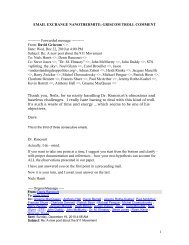court of appeal for ontario - academicfreedom.ca
court of appeal for ontario - academicfreedom.ca
court of appeal for ontario - academicfreedom.ca
Create successful ePaper yourself
Turn your PDF publications into a flip-book with our unique Google optimized e-Paper software.
the earlier action;<br />
(c) the <strong>ca</strong>use <strong>of</strong> action in the earlier action must not have been separate and distinct from the<br />
<strong>ca</strong>use <strong>of</strong> action in the subsequent action; and<br />
(d) the basis <strong>of</strong> the <strong>ca</strong>use <strong>of</strong> action in the subsequent action either was argued in the earlier<br />
action or could have been argued if the parties had exercised reasonable diligence.<br />
Doering v. Grandview (Town) [1976] 2 S.C.R. 621 (S.C.C)<br />
(b) Issue estoppel.<br />
[38] He submitted all <strong>of</strong> the following criteria have not been met:<br />
(a) the same question must have been decided;<br />
(b) the judicial decision said to create the estoppel must have been final;<br />
(c) the parties or their privies must have been the same as they were in the proceedings in which<br />
the estoppel is raised.<br />
Angle v. Minister <strong>of</strong> National Revenue 47 D.L.R. (3d) 544 (S.C.C. May 27, 1974);<br />
Machin et al. v. Tomlinson (2000) 51 O.R. (3d) 566, [2000] O.J. No. 4338 (Ont. C.A.<br />
November 20, 2000) at paragraph 2.<br />
[39] In any event, he submitted this Court should refuse to grant the order sought, as to grant<br />
it would be unfair and unjust to do so. See Minott v. O'Shanter Development Co. [1999] O.J. No.<br />
5, 42 O.R. (3d) 321 (Ont. C.A. January 7, 1999) at pages 340 to 343.<br />
[40] He cited Danyluk v Ainsworth Technologies Inc. [2001] 2 S.C.R. 460, where Binnie J. <strong>for</strong><br />
the Supreme Court <strong>of</strong> Canada said that the rules governing issue estoppel should not be<br />
mechani<strong>ca</strong>lly applied. Their underlying purpose is to balance the public interest in the finality <strong>of</strong><br />
litigation with the public interest in ensuring that justice is done on the facts <strong>of</strong> the particular<br />
<strong>ca</strong>se. The first step is to determine whether the moving party has established the pre-conditions<br />
to the operation <strong>of</strong> issue estoppel. If successful, the Court must still determine whether, as a<br />
matter <strong>of</strong> discretion, issue estoppel should be applied.<br />
[41] Counsel <strong>for</strong> Hilltop submitted that in the circumstances here, where findings have already<br />
been made that Katana’s conduct was planned and deliberate and intended to defeat Hilltop’s<br />
legal rights, where Hilltop has obtained a judgment <strong>of</strong> approximately $5.5 million, but has<br />
collected only $24,000, the Court’s discretion should be exercised in Hilltop’s favour.<br />
Test on a Rule 21 Motion<br />
[42] Counsel <strong>for</strong> Hilltop submitted Katana has not met the test under Rule 21. Be<strong>for</strong>e striking<br />
out a claim, this Court must be satisfied that it is “plain, obvious and beyond doubt” that a claim<br />
<strong>ca</strong>nnot succeed. See Air India Flight 182 Disaster Claimants v. Air India (1987) 62 O.R. (2d)<br />
130; MacDonald v. Ontario Hydro (1994), 19 O.R. (3d) 529<br />
10<br />
2003 CanLII 45839 (ON SC)



